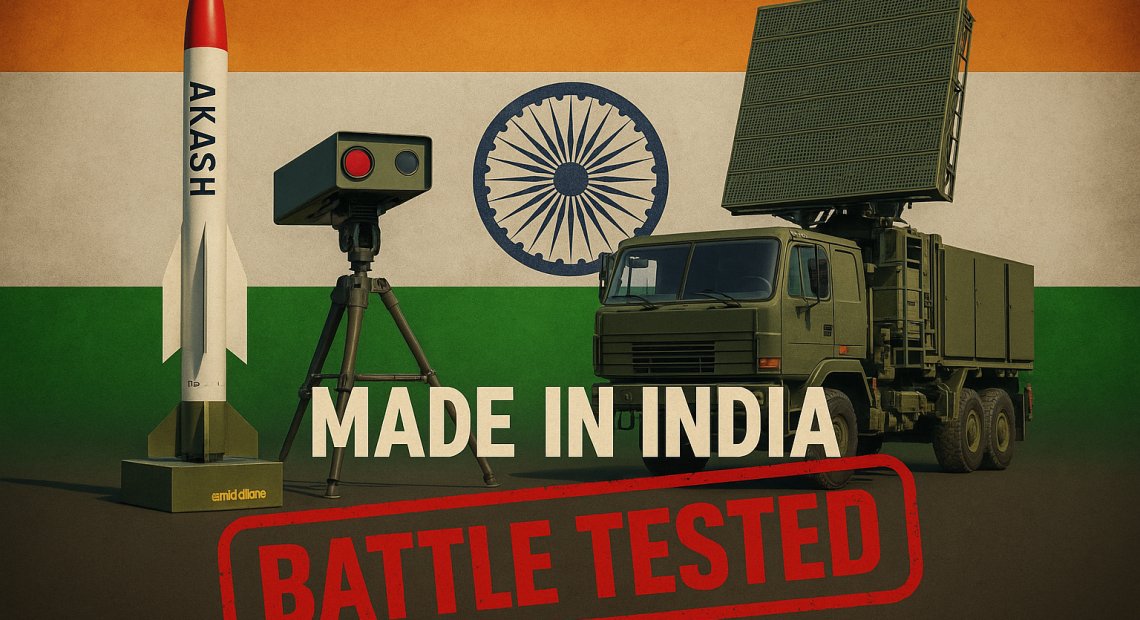
After Sindoor: How India’s Battle-Proven Defences Can Redraw the Global Arms Map
When India launched Operation Sindoor, it wasn’t just retaliating against terrorism—it was testing itself. For decades, India has built its military power quietly, focused more on deterrence than demonstration. But what unfolded over the past week was not a military exercise. It was a real-world confrontation, under real threat, with real stakes. And India’s performance, as revealed by the DGMO press briefing, was more than satisfactory—it was transformative.
This was the first time all three service heads—Army, Air Force, and Navy—jointly addressed the nation and laid out exactly what India faced, how it responded, and how effectively its systems held up under pressure. What emerged from this briefing wasn’t just a story of retaliation. It was the debut of a confident, capable, and self-reliant India—and the world was watching.
What India Used—and What It Proved
India deployed a multi-layered air defence network that included both old Soviet-era platforms and cutting-edge indigenous systems. Among them:
- Akash Surface-to-Air Missiles (DRDO-made)
- Pechora and OSA-AK (legacy Soviet systems still in service)
- Low-Level Air Defence (LLAD) guns
- Man-portable air defence systems (MANPADS)
- Indigenous Counter-UAS systems, both soft-kill and hard-kill
- Carrier Battle Group assets, including MiG-29K jets and AEW helicopters
- ISCCS (Integrated Space Command & Control System), the brain behind it all
Every layer worked. Every asset fired. And none of India’s military installations were breached. From the skies of Jaisalmer to the radar domes on the Navy’s carrier decks, India’s defences functioned exactly as designed.
What the Enemy Threw—and What Failed
On the other side, Pakistan deployed a foreign-sourced arsenal, largely composed of Chinese and Turkish technology:
- The PL-15, a long-range air-to-air missile from China, missed its target
- Bayraktar TB2 drones from Turkey were shot down with ease
- Long-range artillery rockets, loitering munitions, and surveillance UAVs were all intercepted or disabled mid-air
- The wreckage of these systems was displayed publicly by India—a first in modern Indian military history
The message was unmistakable: battle-tested Chinese and Turkish weapons were defeated by Indian-designed, Indian-operated systems. And that wasn’t lost on foreign military observers.
Lessons Learned—and Lessons Yet to Come
While India’s performance was impressive, it wasn’t a full-spectrum test. Pakistan did not unleash hypersonic glide vehicles, cruise missile swarms, or multi-theatre offensives. There were no ballistic missile interceptions, and cyber-electronic warfare was limited.
So India must now prepare for the next leap:
- Develop and test anti-hypersonic capabilities
- Expand its early-warning radar coverage
- Stress-test its air defence grid against simultaneous, multi-vector attacks
- Build AI-enabled threat response loops that reduce human latency
But perhaps most importantly, India must now sustain and expand the ecosystem that made this response possible.
A Decade of Discipline Pays Off
All three military chiefs made a point to credit the last ten years of consistent policy and budgetary support. India didn’t become capable overnight. It took a decade of:
- Prioritized funding
- Defence indigenization push (Make in India, Atmanirbhar Bharat)
- Inter-service integration reforms
- R&D continuity across governments
What Operation Sindoor showed is that when political will matches military need, India’s defence architecture is not just functional—it is formidable. But resting on laurels now would be a mistake. India must:
- Scale production of Akash, counter-UAS systems, and integrated radars
- Create export variants with modular customization for partner nations
- Launch a joint command focused exclusively on hybrid threats
- Double down on AI-driven command and control
Battle-Tested is the New Badge of Honour
In today’s world, arms buyers don’t want PowerPoint presentations—they want proof. Operation Sindoor gave India just that. It proved, for all to see, that:
- Bayraktar TB2s—once considered invincible in Armenia and Libya—could be shot down by Indian systems
- PL-15 missiles from China, touted as superior to American AMRAAMs, failed to hit their target
- Loitering drones, artillery rockets, and aerial threats were all intercepted within Indian territory
This makes India a rare entity: a non-Western power with battlefield-proven systems that are affordable, customizable, and politically non-threatening to smaller or neutral states.
The Global Queue for Help—And India’s Place in Line
Some nations already understand the value of this. Armenia is buying Akash SAMs and Swathi radars. Vietnam is in talks for Akash and BrahMos. The Philippines has signed a BrahMos deal and is now eyeing drone defences. And the list keeps growing:
- Egypt, struggling to replace ageing Soviet stock, is exploring Indian alternatives
- Indonesia, wary of Chinese encroachment, wants radar and missile net coverage
- Sri Lanka see India’s low-cost systems as ideal for coastal and UAV threats
India’s products are now being chosen not because they’re cheap—but because they work in battle.
Japan, South Korea, UAE—India’s Next Strategic Buyers?
Beyond the usual partners, even major regional powers are taking note. Japan and South Korea, while technologically advanced, have yet to field battle-tested counter-drone systems at scale. India’s indigenous UAS-defence models are:
- Faster to deploy
- Much cheaper than U.S./European equivalents
- Not subject to Western export lobbies or strings
UAE, after facing Houthi drone strikes, is looking for drone shields. India can now offer them an off-the-shelf solution, battle-certified, and geopolitically non-aligned.
India’s unique value? It doesn’t come with an ideological cost, nor does it threaten a buyer’s foreign policy.
Russia—A Future Customer, Not Just a Supplier?
Ironically, even Russia might become a downstream client. With its defence industry overstretched due to the Ukraine war and Western sanctions, Russia is struggling to meet the needs of its former satellite states.
India can:
- Retrofit legacy Soviet systems (Pechora, OSA) with Indian radars, command modules, and interceptors
- Provide cheaper replacements for depleting Russian missile stockpiles in Central Asia
- Offer post-Soviet states a non-threatening supplier who understands their Soviet infrastructure
This is a geopolitical inversion: India once imported defence from Russia. Now, it could support Russia’s old clients—perhaps even Russia itself.
From Strategic Autonomy to Strategic Leverage
India has long been a foreign policy lone wolf—non-aligned, independent, unpredictable. While this won it freedom, it also made many countries see India as hard to engage with because there was little they could “gain” from New Delhi.
That changes now.
With battle-proven technology and credible performance, India becomes useful, even without alliances. A Vietnam, Philippines, or Armenia doesn’t care about India’s non-alignment—they care that India can supply what works.
And this translates to:
- More diplomatic goodwill
- Stronger voices in multilateral forums
- Greater weight behind defence proposals
- And perhaps, a slow shift in how the West views India’s role in stabilizing Asia
India doesn’t need to join alliances to be respected. Now, it only needs to be effective—and consistent.
Conclusion: The Sindoor Doctrine Begins
Operation Sindoor will be remembered as the moment India proved that defending sovereignty doesn’t require foreign systems or validation. It requires clarity, continuity, and confidence.
What India showed the world wasn’t just retaliation. It was a doctrine: Precision over posturing. Proof over promises. Self-reliance over dependence.
If India leverages this moment wisely, the road ahead could be more than just diplomatic—it could be transformational.
The world is looking for shields.
India just raised one—and showed that it holds.


















